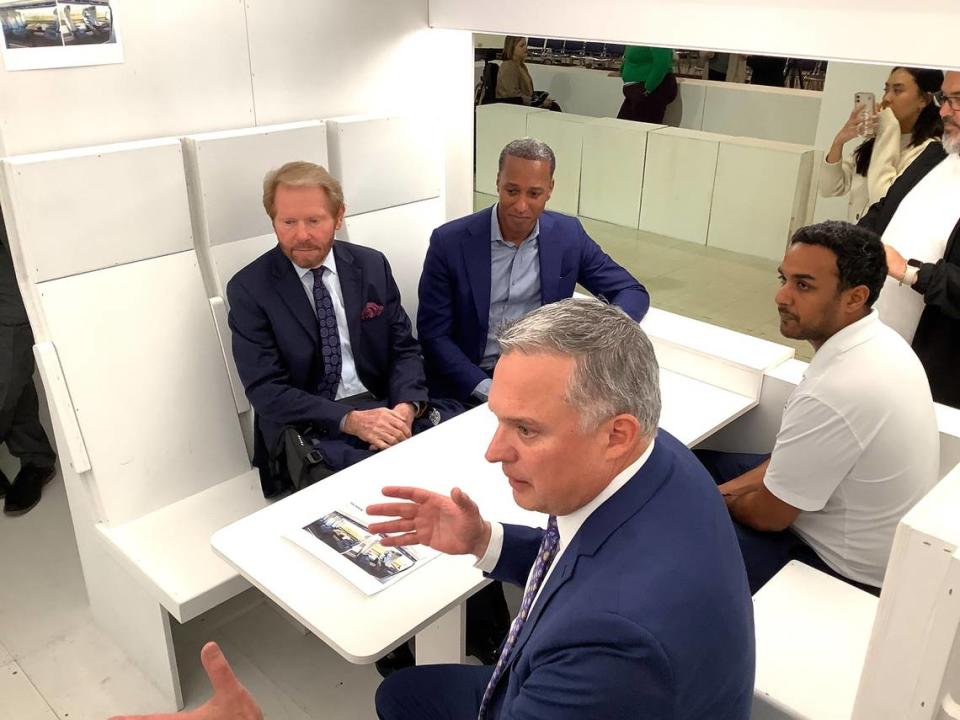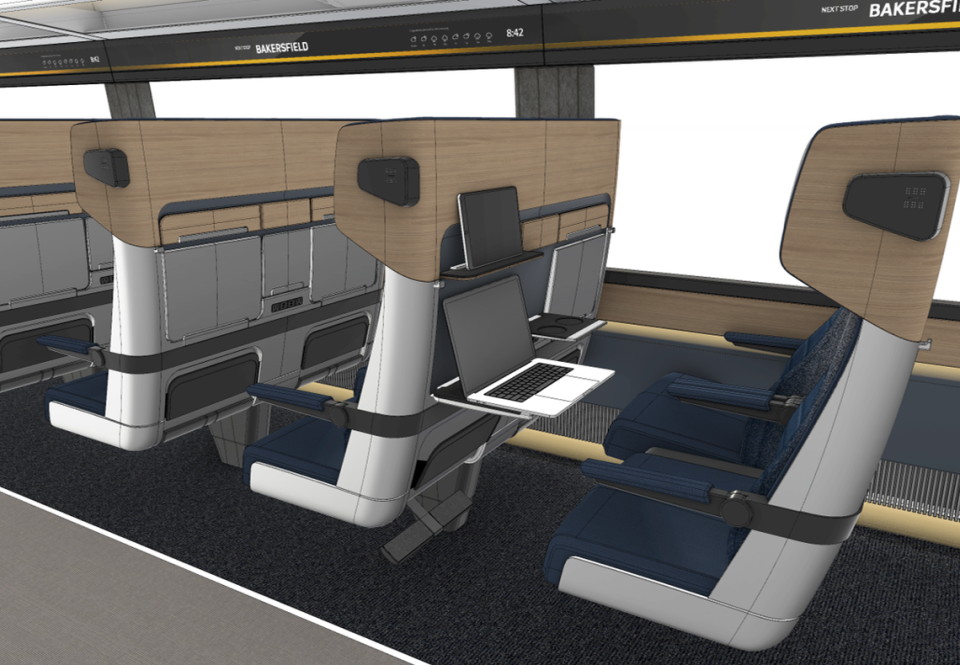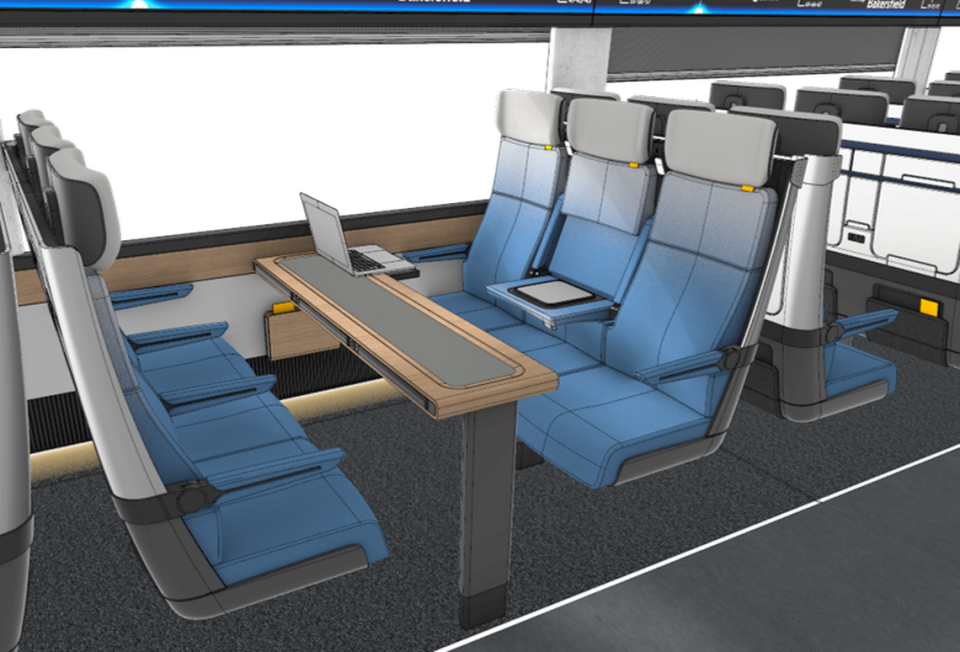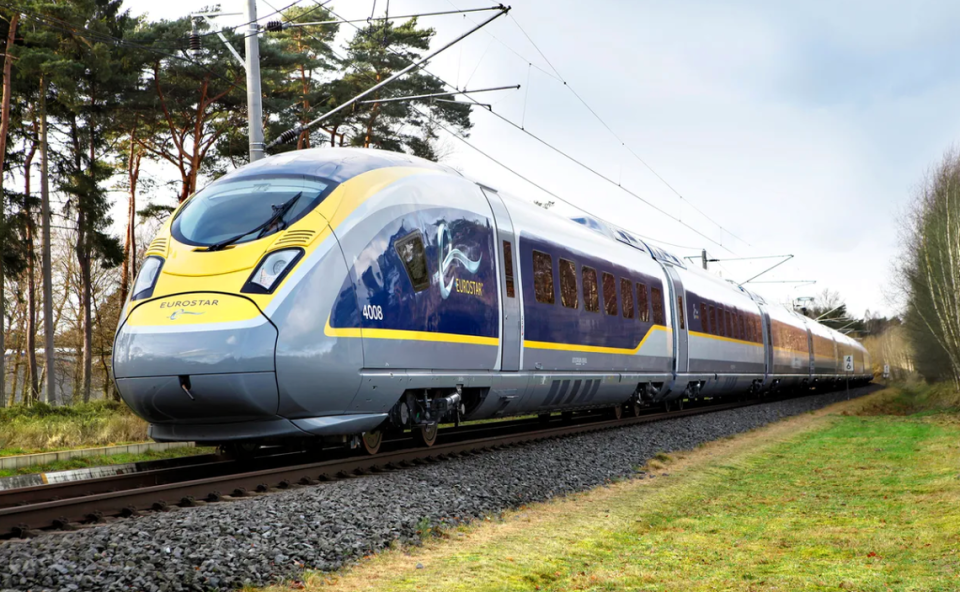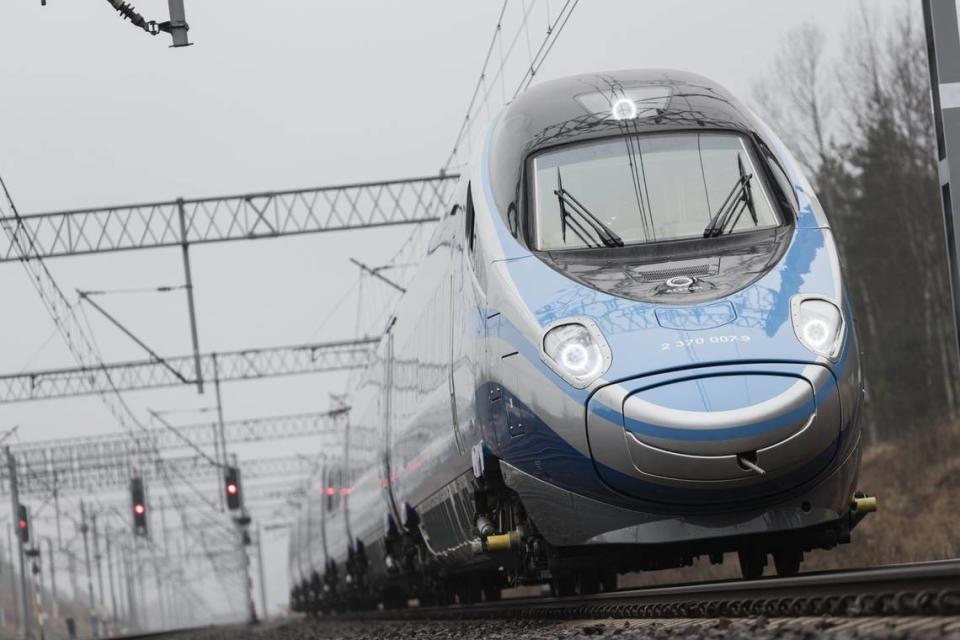What will Californians get for $561 million in future high-speed trains? Here’s a look
The California High-Speed Rail Authority expects to begin carrying passengers on high-speed trains on an initial Merced-Fresno-Bakersfield operating stretch sometime between 2030 and 2033. But the state agency is already trying to give would-be ticket-buying passengers an idea of what they can expect for an investment of more than a half-billion dollars.
For months, the rail authority’s staff has been reaching out to student groups, families, disability advocates, engineers and others to gather feedback on what kinds of seating options, amenities and other features they want to see when the trains begin rolling. The result is an ongoing evolution of plans and renderings that will likely be finalized later this year, after the agency formally puts out a call for bids to manufacturers to build the first batch of six trainsets.
At the Cal Expo state fairgrounds in Sacramento, members of the rail authority’s board got a firsthand look at a full-scale plywood mockup of a partial trainset interior following their Feb. 29 meeting.
The nearest comparison that most Valley residents have for train travel is the Amtrak San Joaquin line that shares freight rail tracks between Bakersfield, Oakland and Sacramento — rail cars in which seats are set four across, two on each side of a center aisle.
But Frank Banko, a consultant working with the rail authority on the trainset design process, said that the high-speed trains will be a foot wider than Amtrak’s cars, offering a great deal more flexibility for seating options, not unlike first-class, business class and economy seating on commercial airliners.
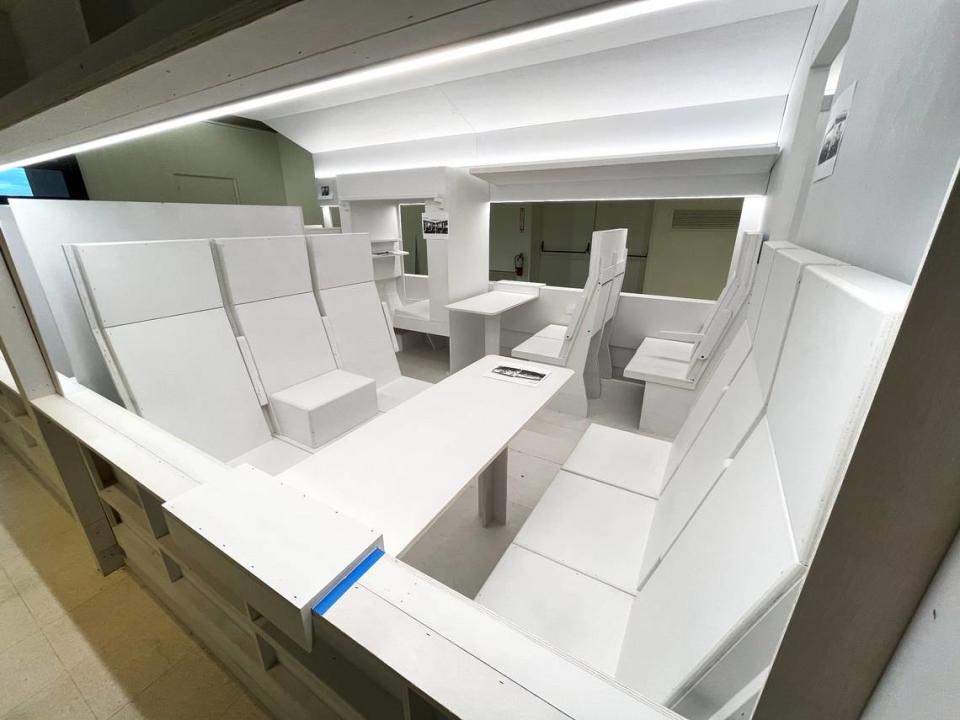
Among the unique features under development are a “family area” of trainsets that offer an open design for parents with children who could grow antsy sitting in a regular train set, said Melissa Figueroa, the authority’s chief of strategic communications who has spearheaded the public outreach effort. “We won’t want families, especially parents of young children, to be confined to just one spot,” Figueroa told board members. “We want them to be able to move around the train and feel welcome and encouraged to do so.”
The family areas could also be booked by groups, such as people traveling to sports events or concerts or student groups who want to congregate aboard the train, Figueroa added.
Current concepts for the family area include a beach motif with surfboards and a raised area intended to resemble a lifeguard station, as well as ample area for children to play.
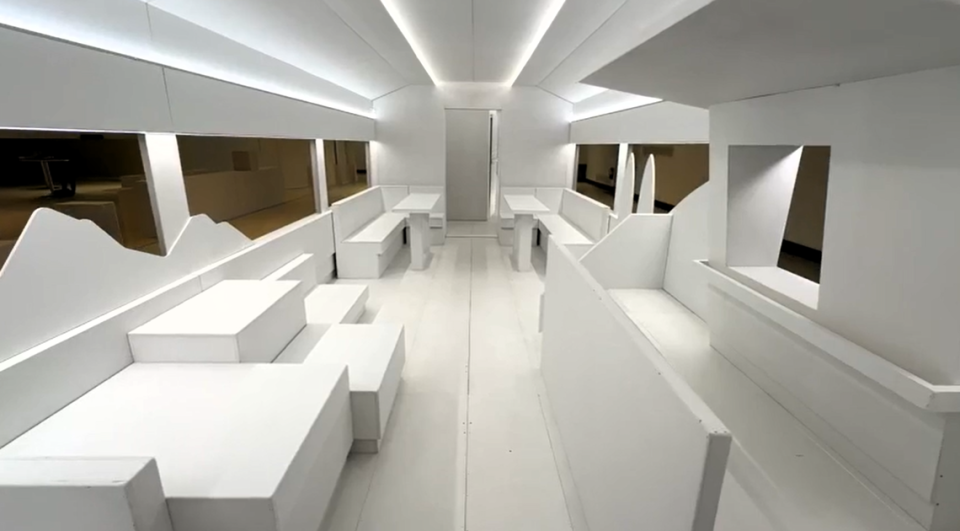
Wide aisles and large restrooms in each passenger car are intended to provide improved access for mobility-impaired people compared to airliners and conventional Amtrak trains. “Our goal is to have anyone with a mobility device (such as wheelchairs, motorized scooters or walkers) to be able to go from end to end on our trains seamlessly and without interruption,” Figueroa said.
Each trainset is expected to offer several different seating options besides the family area, Barko said:
Conventional-style “flex” seating with three seats on one side of the center aisle and two seats on the other side.
“Comfort” seating with two larger seats on each side of the center aisle.
“Premium seating” with one seat on each side of the aisle.
Larger single-seat “cocoon” pods with privacy screens that can be pulled down for seclusion. Those seats, Figueroa said, could accommodate nursing mothers, people who require a more solitary place to work while on the train, or people with conditions that need to avoid excessive sensory stimulation.
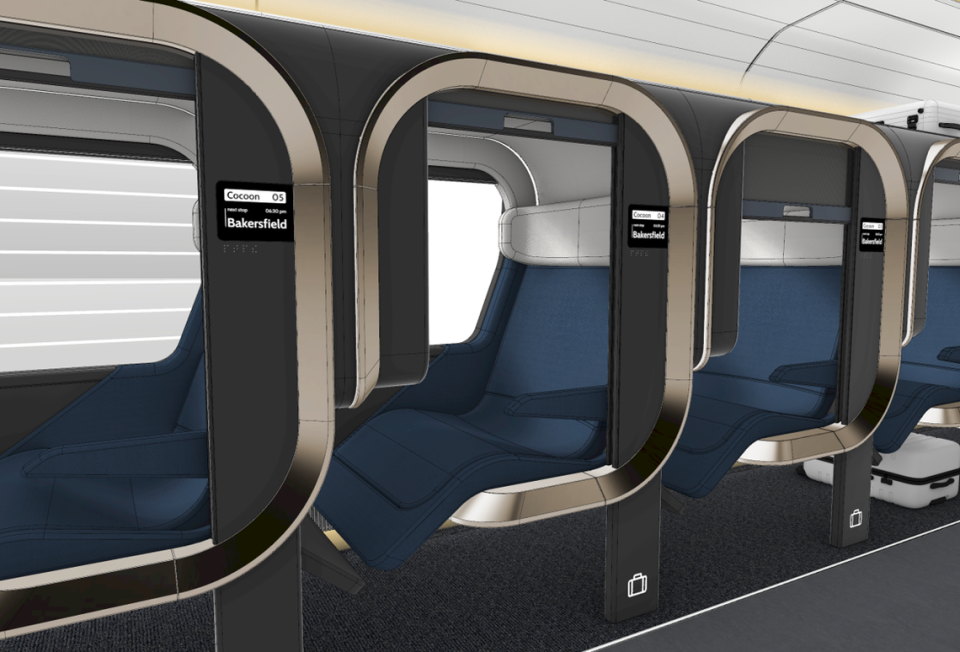
Each 200-meter-long (roughly 650 feet) trainset would have a control cab at each end with passenger cars in the middle; two trainsets could be linked nose-to-tail to create a quarter-mile-long double train capable of hauling 900 to 1,000 passengers in periods of peak demand.
Banko said the initial expectation is for about 60% of the seats on each trainset would be the “comfort seating,” with the rest of the seating comprised of the other seating types. At maximum capacity, each trainset would be able to carry about 450 passengers, but depending on the amenities and seating configurations, the actual passenger load would be likely be 350 to 370 people.
He added that depending on demand for different kinds of seating, modular construction would allow for changes to the seating configurations when the trains undergo periodic maintenance.
Who’s going to build the trains?
One issue for any contractor bidding to build and sell the trains is “Buy America” requirements for the trains to be manufactured in the United States. Currently, no train manufacturer is building anything on American soil running at speeds of 200 mph or more.
Last year, the California High-Speed Rail Authority determined that two global companies had the technical expertise to qualify for bidding on the project: Siemens Mobility, a subsidiary of German company Siemens AG, and French multinational train builder Alstom SA. Both companies have manufactured high-speed trains used in other countries for decades.
Siemens has a manufacturing plant in Sacramento where it builds rail cars and conventional locomotives for other train systems. Alstom is building trainsets at plants in New York for Amtrak’s 160-mph Acela line in the Northeast Corridor between Boston and Washington, D.C.
The actual cost of the trains won’t be known until bids come in for the anticipated order of six electric-powered trainsets. The rail authority expects to issue its request to Siemens and Alstom for bids this spring. The estimated budget for the trains is about $561 million — a figure that is expected to not only cover the purchase of the trains, but also 30 years of maintenance and a driving simulator for training.
Each trainset would consists of multiple cars and electric power units that will be fed by overhead electrical lines and capable of operating at speeds up to 220 mph and testing at up to 242 mph. The state anticipates ordering two prototype trainsets for delivery in 2028 to test not only the trains but also the tracks and systems on the route now under construction in the central San Joaquin Valley.
Money to pay for the trainsets is coming from a $3.1 billion grant awarded in December 2023 to the state by the Federal Railroad Administration.
Where is California’s high-speed train route?
Construction continues in the central San Joaquin Valley on 119 miles of the high-speed rail line from north of Madera to Shafter in Kern County. The state is planning and engineering extensions of that route north to Merced and south to Bakersfield to be the first segment of a statewide system to be put into service.
The latest cost estimates for construction of the Merced-Fresno-Bakersfield segment range between $29.8 billion and $32.9 billion.
Future extensions are envisioned heading west through the Pacheco Pass to Gilroy, San Jose and the San Francisco Bay area and south from Bakersfield to Palmdale, Burbank and Los Angeles/Anaheim. But those additional stretches won’t be undertaken until or unless the state identifies how it would come up with the money to build them.
The estimated cost for the entire Phase 1 system connecting San Francisco and Los Angeles/Anaheim by way of the San Joaquin Valley ranges from $89 billion to $129 billion, according to the California High-Speed Rail Authority’s 2024 draft business plan.
